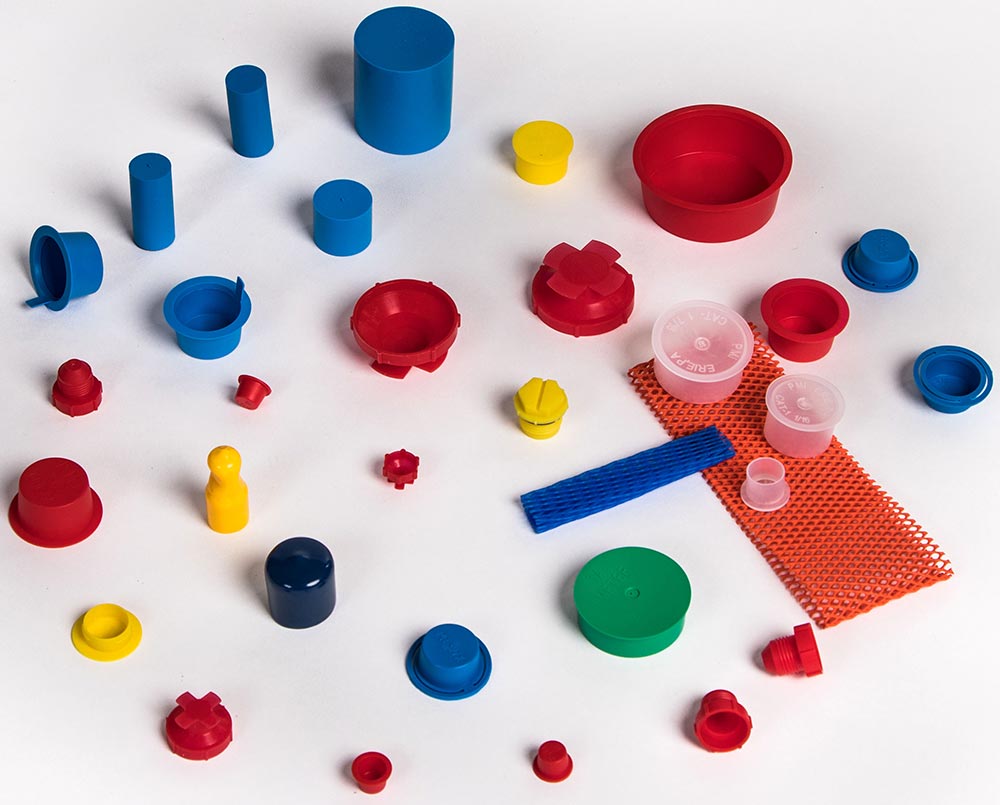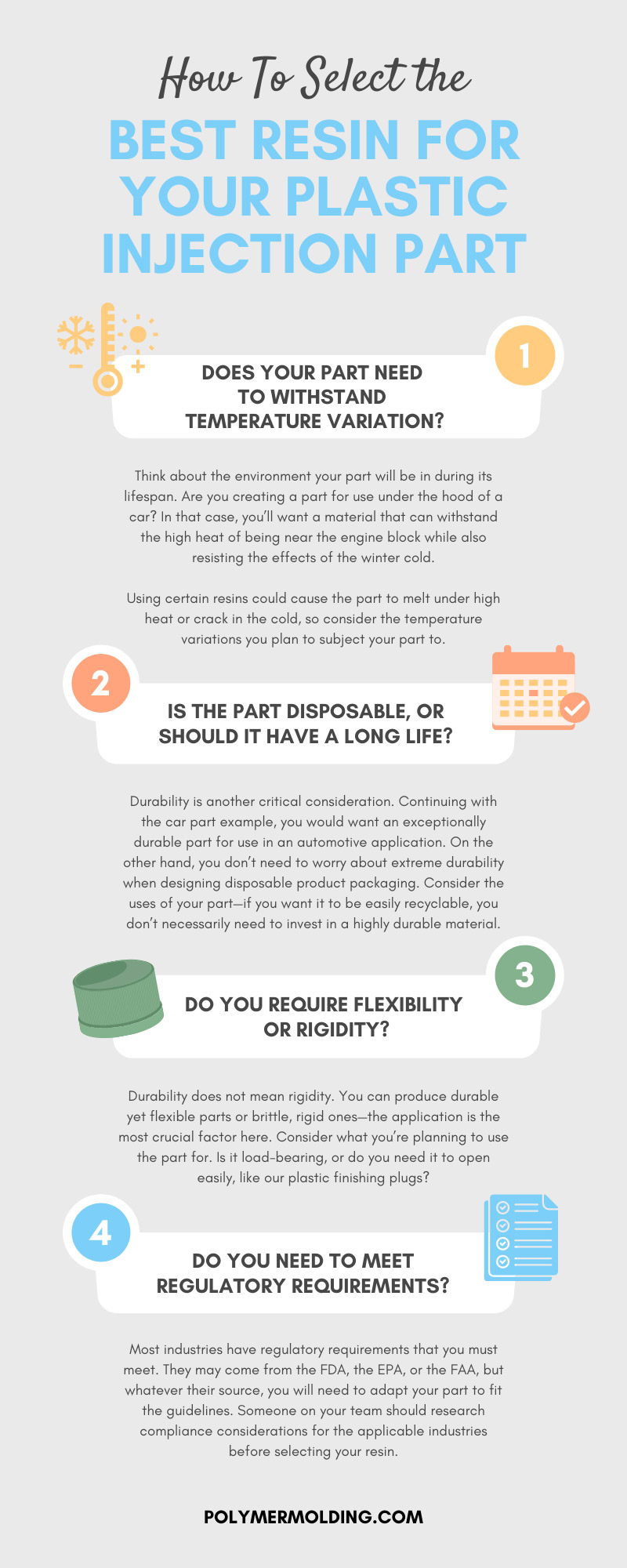News & Events


How To Select the Best Resin for Your Plastic Injection Part
There are so many considerations to keep in mind when choosing the right resin for your injection molding project. With all the different plastic materials available, you have hundreds of options, each with its own unique properties that can influence a part’s performance.
We’re here to make the selection process a bit easier by breaking down how to select the best resin for your plastic injection part. It all begins with a few key questions—once you have the answers, you can dive deeper into technicalities like thermoset plastics vs. thermoplastics or amorphous vs. semi-crystalline resin. If none of that makes much sense yet, don’t worry. Read on to discover a few simple questions to start the decision-making process.
Questions To Ask
There are a handful of essential questions you should ask when you’re considering which resin to use for your plastic injection part. Knowing the answers to these questions can point in the right direction.
Does Your Part Need To Withstand Temperature Variation?
Think about the environment your part will be in during its lifespan. Are you creating a part for use under the hood of a car? In that case, you’ll want a material that can withstand the high heat of being near the engine block while also resisting the effects of the winter cold.
Using certain resins could cause the part to melt under high heat or crack in the cold, so consider the temperature variations you plan to subject your part to.
Is the Part Disposable, or Should It Have a Long Life?
Durability is another critical consideration. Continuing with the car part example, you would want an exceptionally durable part for use in an automotive application. On the other hand, you don’t need to worry about extreme durability when designing disposable product packaging. Consider the uses of your part—if you want it to be easily recyclable, you don’t necessarily need to invest in a highly durable material.
For example, a disposable food container may employ polypropylene in its construction since that is a low-cost material that is easy for users to recycle. Polycarbonate would be a better choice for a medical-grade product.
Does the Part Need To Look Good?
When selecting your resin, you need to think about aesthetics. The first question is: Do they matter? If you design a part for use in an exclusively functional application, the look of the part does not matter in the slightest. However, if you want the part to catch a buyer’s eye, you may want to select a resin with a particular color or glossiness.
The key is to balance performance and aesthetics when designing parts for toys, car interiors, and other products with visual elements.
Do You Require Flexibility or Rigidity?
Durability does not mean rigidity. You can produce durable yet flexible parts or brittle, rigid ones—the application is the most crucial factor here. Consider what you’re planning to use the part for. Is it load-bearing, or do you need it to open easily, like our plastic finishing plugs?
Some materials can only function in one way or the other. For example, polycarbonate is a naturally rigid plastic, while polyethylene is much more flexible. However, there are also resins like PVC that you can make rigid or flexible depending on your requirements.
Do You Need To Meet Regulatory Requirements?
Most industries have regulatory requirements that you must meet. They may come from the FDA, the EPA, or the FAA, but whatever their source, you will need to adapt your part to fit the guidelines. Someone on your team should research compliance considerations for the applicable industries before selecting your resin.
Depending on your industry, the most important factors will be durability, strength, and whether the material is food safe.
Does the Part Need To Withstand Loads?
Finally, if your part needs to withstand specific mechanical or physical loads, you will need to confirm that the material you select is capable of the task. In addition to strength, you should also factor in impact resistance.
Thermoset vs. Thermoplastic
Thermoset plastics and thermoplastics are the two basic categories of all plastic materials. What’s the difference? Thermoset plastics set during the heating process. A chemical reaction caused by heat leads the material to solidify in a permanent form. Once you set these plastics, you can’t reshape or even re-melt them—that feature makes these materials difficult to recycle.
Thermoplastics work the way you’d expect plastic to. When you heat it up, you can mold it into a part, cool it, and have it set as that part. However, when you heat it again, you can re-mold it. This versatility makes thermoplastics easy to recycle and is the main reason that thermoplastics are the most ubiquitously used material today.
Types of Resin
Now that you know a little about the categories of plastics, let’s talk about types of resin. The two main types are known as amorphous and semi-crystalline. All polymers are a series of structures with different crystallinity—it may sound complicated, but it simply refers to how the molecules are packed together. The more crystalline a polymer is, the more strong and rigid it will be.
Amorphous
When you think about clear plastics like polycarbonate, ABS, PETG, and acrylic, you’re thinking about amorphous resin. These options are naturally translucent, they soften over a wide range of temperatures, and there is little to no shrinkage as they cool. However, amorphous resins are prone to stress cracking, have low dimensional stability, and don’t resist fatigue well.
Semi-Crystalline
Semi-crystalline resins contain much more molecular order than amorphous resins. They won’t soften as the temperature gets hotter and instead have a very narrow melting point. Nylon and acetal are two commonly used semi-crystalline resins.
Semi-crystalline resin resists stress cracking and fatigue, making this resin ideal for bearing weight in structural applications. However, you need to watch for shrinkage as the resin cools, and you may find it difficult to bond with adhesives and solvents.
Now that you have a better idea of how to select the best resin for your plastic injection part, contact our team at PMI today and allow us to help fabricate your part!


